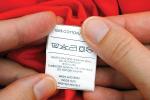OAKBROOK TERRACE, Ill. — If you run a self-service laundry operation, then you’re leaving the cleaning and stain removal up to your customers. But if you offer wash/dry/fold services and are doing laundry for your customers, then your need to know and understand the basics of garment care is much greater.
For a webinar last month, the Coin Laundry Association asked Jeff Gardner, who owned and operated a Minnesota-based residential and commercial laundry services business called The Laundry Doctor for many years before selling it recently, to share his thoughts on some garment care basics.
CHOOSING RIGHT CLEANING PRODUCTS
With so many detergents, bleaches and softeners on the market today, what advice goes Gardner have about choosing the right type of cleaner for the item being washed? Are there any products—or even ingredients—that he suggests avoiding?
“I’m sure other folks have had this happen but I’ve had employees literally dump chlorine bleach accidentally or intentionally—not knowing what the effects were—on a load of colored items, full color, destroyed the entire load and had to replace it.”
Chlorine bleach is good for truly white items and/or polyesters that were dyed before the fabric was made, advises Gardner: “If dye is applied after the product has been made, chlorine bleach will pull it at one point in time or another.”
He believes you can achieve results using oxygen bleach (and “a little bit more temperature on your whites”) that are just as good as using chlorine bleach. Oxygen bleach, even as a liquid, is going to be more effective, he adds.
Because they’re concentrated, powdered detergents are more effective than their more expensive liquid counterparts if you are washing in the proper temperatures, Gardner says. For example, using water that’s hotter than 110 F would be optimal, but you can still get results at temperatures as low as 80.
If you’re in a Northern state like Minnesota, it’s wintertime and you’re running your washers on cold water, even the Tide “wash in cold” products don’t work effectively when the water temperature you’re putting in the drum is less than 50 degrees, he says. Those located in the South and Southwest will never encounter this issue.
Gardner’s WDF operation used chemical injection in which liquid detergent was automatically injected into the wash cycle. “We could do two things: we could dose the proper amount so we weren’t overusing chemicals, and we also made sure we had the (chemical) product that was specific for that.”
And that product was something he called a “nursing home blend.” Most chemical companies offer something that would qualify.
“Most nursing homes deal with a lot of stains: urine, feces, food stains … and they’re washing their own laundry internally,” Gardner explains. “There are products made—one-dose products—that work really well with the equipment we have in vended laundry … It’s a little bit more expensive but it does a great job because it’s built and designed specifically for personal laundry, and personal laundry that are going to have some (cleaning) challenges with it.”
The formula likely contains some enzymes, oxygen bleach, and natural bluing agents to assist in brightening the cleaned garments.
Gardner also likes color catchers, which are sheets designed to absorb and trap any dyes that clothes may release during the wash.
“You never know when you may get a load with what we call ‘fugitive dye,’” he says. “In other words, a dye that did not hold to the garment, just like a red garment the first time you wash it. It’s going to redeposit itself on everything else in the load.”
Gardner says that ammonia and Dawn dishwashing detergent are excellent products for the individual treatment and removal of most stains you’ll see.
Ammonia works well on stains with odors, as well as fatty or greasy stains. Dawn can pre-treat oil, ink or grass stains.
Heavily stained garments may require soaking in an enzyme detergent, and Gardner recommends using a commercial shirt laundry powder.
“You want the detergent with the most enzymes in it because that’s going to (offer the greatest) ability to do this type of cleaning,” he adds. “The more expensive ones will have a broader range of enzymes in them and a higher concentration.”
ASK THE PROS
Any operation that does laundry for its customers benefits from having a good relationship with a professional chemical supplier, according to Gardner.
“Whether it be your drycleaning supplier or an industrial laundry supplier, they’re the ones who are going to be able to help you with your specific problem,” he explains. “There are a lot of things to think about when you’re doing laundry for somebody else.
“You can get into the pH of your water. You can get into the hardness of your water. … My chemical supplier checks our pH regularly when he comes out to make sure the balances are all correct in the loads and making sure we’re getting the right doses for what we want.”
Water’s pH level and hardness can change regularly depending on the source, which can impact wash chemistry effectiveness.
“They’re also a regular resource,” Gardner says of chemical suppliers. “You can pick up the phone and call them if you have a problem and a good supplier will solve that problem for you.”
Miss Part 1? You can read it HERE
The Coin Laundry Association frequently offers webinars that cover topics such as marketing, store operations and management, and new investor education. Visit www.coinlaundry.org/events/webinars to learn more.
Have a question or comment? E-mail our editor Bruce Beggs at [email protected].








